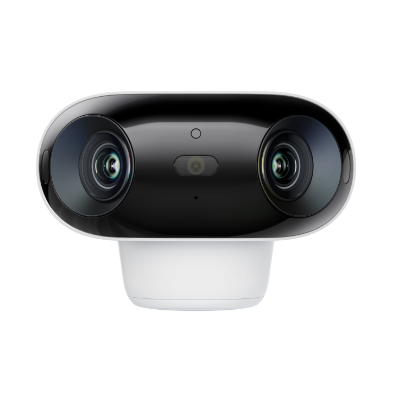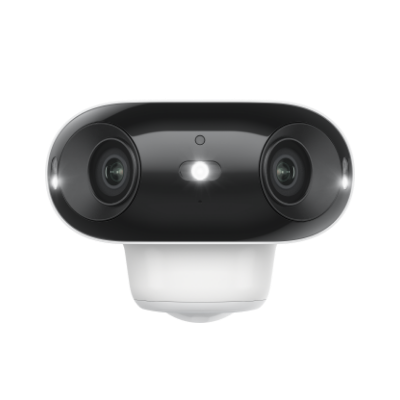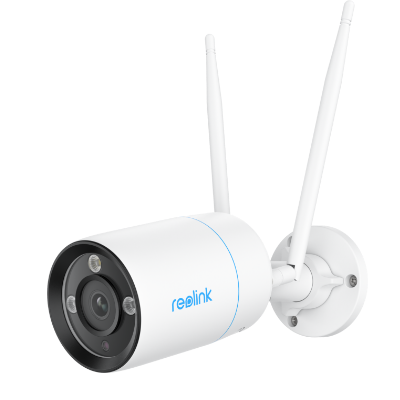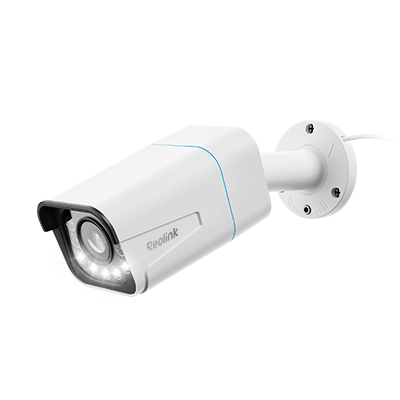IP Rating for Security Cameras: Why Does It Matter?
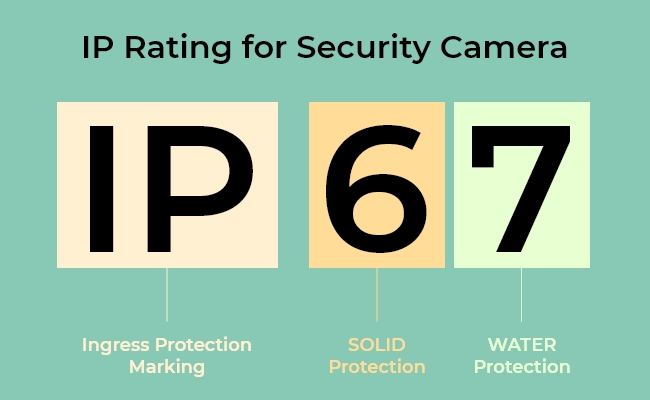
Security cameras must withstand different elements, provide clear surveillance in various conditions, and maintain functionality over time. IP ratings indicate the camera's ability to endure the challenges of outdoor and indoor security applications. This article will explore the meaning of IP ratings in security cameras and enlist an IP rating chart to help you make the right choice.
- What is the IP Rating in Security Cameras?
- IP Rating Components: Two Digits
- IP Rating Chart for Security Cameras
- Why Are IP Ratings Important for Security Cameras?
- How to Choose the Right IP Rating for Security Cameras
- Best Waterproof Security Camera Recommendation
- IP Rating vs. IPX Rating: What's the Difference?
- Bonus Tips: Understanding IK Rating for Security Camera
- FAQs
- Conclusion
What is the IP Rating in Security Cameras?
IP rating, short for Ingress Protection rating, is an international standardized measure used to specify the level of protection that security cameras, as well as other electrical and electronic devices, offer against dust, moisture, and solid objects. The IP rating is typically represented by the letters "IP" followed by two digits, such as "IP67 cameras".
IP Rating Components: Two Digits
The IP rating is composed of two different digits and each has its meaning.
Dust Resistance
The first digit in the IP rating indicates the level of protection against solid objects like dust and debris. It ranges from 0 to 6, with higher numbers indicating greater protection. For example, the "0" indicates the device has no special protection against solid objects, while "6" means that a device is completely sealed against dust ingress. Check the table below:
Water Resistance
The second digit in the IP rating specifies the level of protection against liquids, such as water. It ranges from 0 to 9, with higher numbers indicating higher levels of protection. The "0" indicates there is no special protection against liquids and the "9" means that the equipment is protected against high-pressure, high-temperature jets of water. The following table indicates the specific meaning of each number.
IP Rating Chart for Security Cameras
Security cameras are often used in various environmental conditions and different models come with specific ratings to indicate their resistance to dust and water. The common range of IP ratings for security cameras falls from IP65 to IP68. The following chart includes some standard IP ratings for security cameras.
Why Are IP Ratings Important for Security Cameras?
IP ratings define the camera's ability to withstand environmental conditions and maintain reliable performance. These ratings are important for security cameras due to the following reasons:
Protection from Dust and Water
People often use security cameras in outdoor spaces, such as industrial settings or natural environments, where there exists the potential exposure to rain, splashes, dust, or even submersion. An appropriate IP rating ensures that the camera is dust-tight and waterproof. A higher IP rating means that the camera can prevent the intrusion of particles and withstand water without damage, maintaining clear and unobstructed video footage.
Durability and Longevity
Security cameras with higher IP ratings are designed to withstand harsh environmental conditions. Investing in cameras with appropriate IP ratings ensures longevity and reduces the need for maintenance or replacements due to damage from exposure to external elements.
Reliability in Extreme Conditions
The IP rating is crucial for ensuring continuous security monitoring in extreme conditions. For example, in critical surveillance applications, such as monitoring in harsh climates or extreme weather conditions, IP-rated cameras can be relied upon to continue functioning without interruptions.
Compliance with Regulations
Different applications and industries may have special regulatory requirements for security camera installations. Knowing the specific IP rating standards ensures that the installation of surveillance devices complies with these regulations.
How to Choose the Right IP Rating for Security Cameras
Choosing the right IP rating for security cameras depends on the environmental conditions where the cameras will be installed. You can follow these steps to select the appropriate rating for your device.
Assess the Installation Environment
The first thing you need to do is consider where the cameras will be installed. Is it indoors or outdoors? You can go to the site and identify some potential environmental factors such as exposure to dust, moisture, rain, humidity, extreme temperatures, and the possibility of submersion.
Determine Specific Threats
If you've decided on the installation spot, you also need to consider the types and severity of potential threats your cameras may face in the given environment. For example, in summer is there a risk of splashes, heavy rain, dust storms, or submersion in water? Are there extremely low temperatures in winter? If you're unsure, it's often safer to choose a higher IP rating to provide better protection.
Here are some recommended IP ratings for different environments:
- For indoor use in controlled environments with no exposure to dust or moisture, a lower IP rating such as IP20 may suffice.
- For outdoor cameras exposed to rain and dust, consider IP65 or higher.
- In extremely harsh conditions with heavy rain, high dust levels, or submersion risks, opt for an IP rating of IP67 or IP68.
Consider Additional Factors
In some circumstances, only considering IP rating is not enough. You must consider any unique conditions or requirements that may apply to your situation. For instance, if the camera is near a chemical processing plant, you may need resistance to specific chemicals, which may involve additional codes or requirements beyond the basic IP rating.
Set a Budget and Plan for Future Expansion
Security cameras with higher IP ratings tend to be more expensive. When purchasing, you need to balance your need for protection with your budget. Comprehensive daily surveillance may require more than just one camera so you also need to consider potential future needs. If your surveillance system might expand to more challenging environments, it's a good idea to choose cameras with higher IP ratings from the beginning.
Best Waterproof Security Camera Recommendation
If you are looking for security cameras for outdoor use, consider the IP66 rating or higher. Here are some recommendations for security cameras with high IP ratings.
Best 4K Wireless Waterproof Security Camera - Reolink Argus 4 Pro
Wireless security cameras provide convenient installation and usage for outdoor environments, and one exciting new option is the Argus 4 Pro. This battery-powered camera boasts an IP66 rating, ensuring durability against various weather conditions.
4k 180° Wire-free Color Night Vision Camera
4K UHD 180° Blindspot-free View; Color Vision Day and Night; 30% More Battery Life; Dual-band Wi-Fi 6; Smart detection.
Equipped with Color X technology, it delivers full-color night vision along with spotlights. You can rest assured that the bright spotlight won't cause disturbances when placed outdoors. Additionally, its dual-lens design creates an ultra-wide 180-degree field of view, eliminating blind spots even in challenging weather conditions.
For buyers that require full-color night vision without noticeable lighting, the Reolink Argus 4 Pro is an ideal option. Alternatively, customers looking for a low-cost, high-performance option may choose to explore the regular Argus 4 version.
4k 180° Blindspot-free Wi-Fi 6 Camera
4K UHD 180° Blindspot-free View; Dual-band Wi-Fi 6; Smart detection; Easy Installation Anywhere
Best Plug-In Waterproof Security Camera: Reolink RLC-810WA
The Reolink RLC-810WA employs the high-end dual-band WiFi 6 technology. You can choose the 5GHz band for higher speeds, and the 2.4GHz band for broader coverage. With 4K 8MP Ultra HD resolution and built-in spotlights for color night vision, you can see very details day and night. The biggest standout attribute of the RLC-810WA is its IP67 rating. It can perform at the highest level of excellence, whether under the blistering sun, amidst heavy rainfall, or other challenging climatic conditions.
4K WiFi 6 Surveillance Camera
4K 8MP Ultra HD, Dual-Band WiFi 6, Color Night Vision, IP67 Waterproof, Smart Detection, Two-Way Audio, Built-in Siren.
Best Wired PoE Waterproof Security Camera: Reolink RLC-811A
Designed with versatility in mind, the RLC-811A is perfect for both indoor and outdoor settings. This camera can get a network connection and power supply through just one Ethernet cable, making the installation easier than ever before. The IP67 rating ensures the camera remains fully operational even in extreme weather conditions.
4K Smart PoE Camera with 5 Spotlights
4K 8MP Ultra HD Day & Night, Person/Vehicle Alerts, 5X Optical Zoom, Two-Way Audio, Built-in Siren, Color Night Vision, Live View Anywhere.
The video below shows that Reolink RLC-811A can capture unparalleled clarity even in pouring rain.
IP Rating vs. IPX Rating: What's the Difference?
IP rating and IPX rating are both standards used to define the degree of protection provided by various electrical devices, including security cameras, against the ingress of external objects like dust and water.
The main difference between the IP rating and IPX rating lies in the IP rating consists of two digits (e.g. IP66) and indicates the level of protection against both solids and liquids, while the IPX rating only includes the second digit, which denotes the degree of protection against liquids (water). The "X" in the rating indicates that the protection against solids (dust) is not specified or tested.
For example, an IP67 rating signifies protection against dust (6) and immersion in water up to 1 meter (7). An IPX4 rating indicates protection against splashing water but doesn't specify the level of protection against solids like dust.
Bonus Tips: Understanding IK Rating for Security Camera
IK ratings are a measurement of the resistance to impact or mechanical impact strength for electrical and electronic equipment, such as enclosures, dome security cameras, switches, and control gear. This rating is defined by the International Electrotechnical Commission (IEC) standard 62262 and is expressed in terms of IK followed by a two-digit number. The higher the IK rating, the greater the resistance to impact. The rating ranges from IK00 (no protection) to IK10 (highest level of protection against impacts).
Common security cameras do not use IK ratings because they do not have an enclosure cover. But dome security cameras come with an enclosure to cover the camera lens and often use this rating to indicate the enclosure's ability to resist physical impact. Most dome security cameras in the market have an IK rating of up to IK10.

FAQs
What's the best IP rating for outdoor security cameras?
Outdoor security cameras often have a higher IP rating than indoor cameras because they need to withstand different weather conditions. The best IP rating for outdoor security cameras is IP66 or higher.
Is IP67 waterproof?
IP67-rated security cameras are highly water-resistant and can withstand temporary submersion in water up to I meters (approximately 3.3 feet). However, they are not totally "waterproof" to water under all conditions.
How long can IP66 stay underwater?
The IP (Ingress Protection) rating "IP66" is not specifically designed to indicate how long a device can stay submerged in water. Instead, it is a measure of the device's protection against solids and water. The second digit "6" indicates that the device is highly water-resistant and can withstand powerful jets of water without water ingress. This is typically interpreted as protection against water splashing from any direction.
If you require a device that can be submerged for an extended period, you should look for a device with a higher IP rating, such as IP67 or IP68.
Can IP68 withstand heavy rain?
The answer is yes. An electrical device with an IP68 rating is highly water-resistant and can withstand heavy rain. But note that the specific capabilities of a device depend on its design and construction.
Conclusion
IP ratings show the ability of security cameras to resist water and dust and are important criteria to measure when choosing outdoor security cameras. For outdoor applications, it's often recommended to use cameras with IP65 or higher ratings to ensure they can withstand the elements effectively.
Do you know the IP rating of your security camera? Is it important? Tell us your thoughts in the comment section below and share this article with your family and friends if you find it useful.
Search
Be in the Know
Security insights & offers right into your inbox

